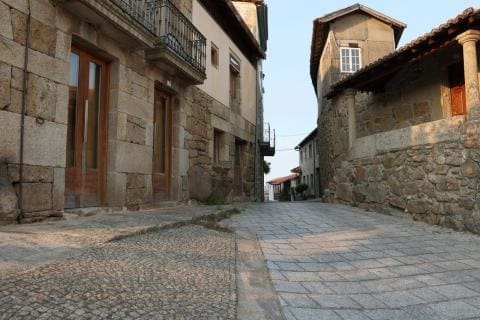It constitutes a very interesting urban ensemble that can be seen from the N-540 on the way from Ourense after a beautiful “carballeira” that has its site in the grand house of Os Rivas. The name Vilanova dos Infantes, which is the most commonly accepted version, could be derived from a legend about the
birth of seven twin sisters, or rather, from the specific fact of the residence of the mother and sister of Saint Rosendo, and those of royal blood like her – the story even speaks of the daughters of Alfonso X – who belonged to the double monastery of Santa María de Vilanova, founded around the year 940 by Ilduara to retire in her widowhood, and to which her daughter Adosinda, sister of Saint Rosendo, soon joined. This monastery would later be annexed to Celanova (presumably as a male priory) and the nuns, including the two royal infants, were transferred to Allariz. Somewhat distant from the medieval village, in the place of Santa María, its pre-Romanesque church, similar to the chapel of San Miguel, was demolished around 1880, with its stone being sold in a short time. Some elements are still preserved in various buildings in the area, as well as in the Provincial Archaeological Museum. In this regard, it is worth highlighting the existence of two corbels with Mozarabic motifs in a house in O Cristal, located next to the N-540 road. The other historical element that identifies Vilanova dos Infantes, along with its urban configuration of structure and probable castreño origin, is the castle, of which the keep is preserved. With a likely common origin with the other fortresses of the 12th century, it belonged for a long time, and with it the village, to the monastery of Celanova. In 1369, Enrique II took it from Don Fernando de Castro to give it to Juan Rodríguez de Biedma. Until recently, the impact of the Irmandiña revolt on its integrity was unknown, although recent archaeological studies have brought to light what could very well be the inner base of the old tower, which substantially modifies this assumption. By the mid-16th century, it was among the main fortresses of Galicia. Through inheritance from the Biedma family, it passed to the house of Monterrey and entered into litigation with the Lemos family. Around 1645, it was reformed for the Hispano-Portuguese border wars, which did not directly affect it. After the Mendizábal Disentailment and until January 1927, when it was added to Celanova, the Vilanova dos Infantes Town Hall was installed in the tower, which is largely responsible for its current preservation. Today, the building houses a permanent exhibition on the history, geography, and economy of the region. The village is urbanistically constituted by a typical hamlet, where granaries and streets that retain a clear medieval character abound. The main element is evidently the keep of the old castle, although also singular and at the same time enigmatic is the existence of a cave popularly known as “San Vivián” which recalls the forms of a more than likely hermitage later reused as a cellar. The parish church is formed by an acceptable baroque and preserves inside one of the main medieval Christs of the province.
Perhaps the one of greatest artistic value, which probably comes from the old monastery of Santa María. The old shoemakers of Vilanova, along with those of Allariz and Noia, enjoyed great fame in Galicia, preserving from this tradition a particular dance of medieval origin, which annually honors, on September 15, the Virgin of Cristal. In this regard, it is worth remembering the veneration that this virgin has throughout the region, a virgin who became especially known thanks to the excellent poem about the legend written by the unforgettable poet from Celanova, Manuel Curros Enríquez.

 Province of Ourense, Galicia
Province of Ourense, Galicia








